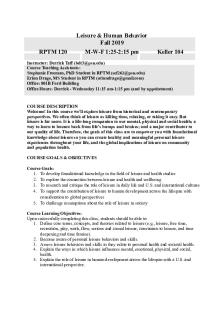ABT 120 Heriditary paper PDF

| Title | ABT 120 Heriditary paper |
|---|---|
| Course | Genetics And Society |
| Institution | University of Kentucky |
| Pages | 3 |
| File Size | 61.5 KB |
| File Type | |
| Total Downloads | 33 |
| Total Views | 154 |
Summary
Weekly paper for ABT 120 about genetics....
Description
Moles are an overgrowth of skin cells called melanocytes. A melanocyte is a mature melanin-forming cell most found in the basal layer of the epidermis. Melanin is the darker brown or black pigment found in hair, eyes, and skin. Melanin is also what is responsible for skin turning darker after tanning. Since moles are excess melanocytes, the appearance of a mole is almost always a darker brown circle that protrudes from the skin or flush. Moles are like cancerous tumors since overactive cell division of skin cells creates both; however, most moles are not cancerous (benign). Cancerous moles are melanoma, and non-cancerous moles are called dysplastic nevi. Though cancerous tumors can result from overactive skin cells, this is not the only cause. Moles that appear at birth are named congenital nevi, and moles that occur in childhood are called melanocytic nevi. Congenital nevi are rare when compared to melanocytic nevi. Interestingly, only one to two percent of the population has moles at birth. However, moles can also appear at later stages as life and can occur due to excessive exposure to ultraviolet radiation. In addition, moles that occur from ultraviolet radiation are more likely to become cancerous. (National Library of Medicine, n.d.) Since birth, I have always inherited moles from my father and his relatives. The term mole is a general umbrella term that has separate subcategories. The main types of moles common within my family are dysplastic nevi and melanocytic nevi. I am part of the one to two percent of people who have had moles appear since birth. As a result, I had regular checkups with specialists who would monitor my moles’ size, shape, and overall progression to determine whether my moles would develop into melanocytic nevi. I have been fortunate enough not to have melanoma thus far, as all my moles have been dysplastic nevi. Moles that have been melanocytic nevi in my relatives were almost entirely caused by ultraviolet radiation instead of
genetic inheritance. Nearly everyone on my dad’s side of the family has moles, whereas my mom and her family only have melanocytic nevi caused by ultraviolet radiation. For this reason, I am led to believe that moles are heritable in my situation. More research and resources have been allocated to researching melanocytic nevi than dysplastic nevi. Melanocytic nevi are believed to be caused by a somatic mutation in the genes (National Library of Medicine, n.d.). Scientists think melanocytic nevi can be inherited, although unlikely. Scientists who believe moles are heritable are still debating whether the trait is polygenic or monogenic (Traupe, 1991). Melanoma is believed to be inherited in an autosomal dominant fashion (National Library of Medicine, n.d.). There is virtually no proof or data to conclude from for dysplastic nevi, although it is thought to contain similar characteristics to melanocytic nevi. Although data sets show correlations between the number of moles in parents and the number in offspring, the correlation may not have any actual significance. Unfortunately, there is limited information about moles, and the heritability of moles is still debated. An interesting fact about melanoma is that it does not necessarily have to be treated. Although rare, melanoma can sometimes be suppressed by a person’s immune system and does not require any treatment. Most cases of melanoma that do not require treatment are since the skin cells spread to other parts of the body, which activates the immune system. Since melanoma does not cause cancer overnight, the immune system typically does not become active into later stages. (Sloan Kettering Institute, 2021)
Works Cited National Library of Medicine. (2022) Are moles determined by genetics?. Medlineplus. Date accessed 13 February 2022.
Plasmeijer, E., Nguyen, T.M., Olsen, C.M., et al. (2017). The natural history of common melanocytic nevi: a systematic review of longitudinal studies in the general population. J Invest Dermatol, 137, (9), 2017-2018. Traupe, H. (1991). Polygenic vs Monogenic Inheritance of Dysplastic Nevi and Malignant Melanoma: Yesterday’s Debate or the Answer of Tomorrow?. Recent Progress in the Genetic Epidemiology of Cancer, 102-113. Sloan Kettering Institute. (2021). 5 Surprising Facts about Melanoma. Memorial Sloan Kettering Cancer Center. Date accessed 13 February 2022. < https://www.mskcc.org/news/five-surprising-facts-about-melanoma>...
Similar Free PDFs

ABT 120 Heriditary paper
- 3 Pages

Ed serpro 21 abt-1 - EDITAL CONCURSO
- 33 Pages

Nutrition 120
- 64 Pages

3-120 solution
- 2 Pages

120 2.2 notes
- 2 Pages

120-10 - Ley 26206
- 4 Pages

NUTR 120 full notes
- 113 Pages

Syllabus RPTM 120
- 13 Pages

ECE-120-History Tabletemplate
- 3 Pages

ISTE-120 Syllabus 081313
- 10 Pages

Microscope lab Bio 120
- 12 Pages

Musicology 120 Essay 1
- 1 Pages

120 team script - Presentation
- 7 Pages

ECE-120-History Tabletemplate
- 4 Pages

120 6.3 notes
- 6 Pages
Popular Institutions
- Tinajero National High School - Annex
- Politeknik Caltex Riau
- Yokohama City University
- SGT University
- University of Al-Qadisiyah
- Divine Word College of Vigan
- Techniek College Rotterdam
- Universidade de Santiago
- Universiti Teknologi MARA Cawangan Johor Kampus Pasir Gudang
- Poltekkes Kemenkes Yogyakarta
- Baguio City National High School
- Colegio san marcos
- preparatoria uno
- Centro de Bachillerato Tecnológico Industrial y de Servicios No. 107
- Dalian Maritime University
- Quang Trung Secondary School
- Colegio Tecnológico en Informática
- Corporación Regional de Educación Superior
- Grupo CEDVA
- Dar Al Uloom University
- Centro de Estudios Preuniversitarios de la Universidad Nacional de Ingeniería
- 上智大学
- Aakash International School, Nuna Majara
- San Felipe Neri Catholic School
- Kang Chiao International School - New Taipei City
- Misamis Occidental National High School
- Institución Educativa Escuela Normal Juan Ladrilleros
- Kolehiyo ng Pantukan
- Batanes State College
- Instituto Continental
- Sekolah Menengah Kejuruan Kesehatan Kaltara (Tarakan)
- Colegio de La Inmaculada Concepcion - Cebu
